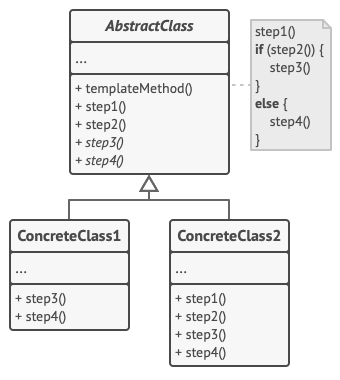策略模式与模板方法模式
1. 策略模式
策略模式是一种行为设计模式,它能让你定义一系列算法,并将每种算法分别放入独立的类中,以使算法的对象能够相互替换。
当你有许多仅在执行某些行为时略有不同的相似类时,可使用策略模式。使用该模式能将类的业务逻辑与其算法实现细节隔离开来。
说白了,其实还是解耦

策略模式的结构如上图所示,主要包含三个角色:
- 抽象角色:通常是一个接口
- 具体角色:接口的具体实现
- 环境角色:调用接口的上下文环境,通常是一段业务逻辑方法
举个常见的例子:支付
先定义一个接口 PayStrategy.java
package com.example.service;
import com.example.domain.dto.PayDTO;
import com.example.domain.dto.PayDetailDTO;
/**
* @author ChengJianSheng
* @date 2021/1/11
*/
public interface PayStrategy {
/**
* 下单
*/
PayDTO prepay();
/**
* 查询
*/
PayDetailDTO query();
/**
* 撤销
*/
void cancel();
/**
* 退款
*/
void refund();
}
然后是具体实现
AlipayStrategy.java
package com.example.service.impl;
import com.alipay.api.AlipayClient;
import com.alipay.api.request.AlipayTradePrecreateRequest;
import com.alipay.api.response.AlipayTradeCancelResponse;
import com.example.domain.dto.PayDTO;
import com.example.domain.dto.PayDetailDTO;
import com.example.service.PayStrategy;
import org.springframework.beans.factory.annotation.Autowired;
import org.springframework.stereotype.Component;
/**
* https://opendocs.alipay.com/open/common/abilitymap
* https://opendocs.alipay.com/open/194/106078
* 扫码支付
*/
@Component
public class AlipayStrategy implements PayStrategy {
@Autowired
private AlipayClient alipayClient;
@Override
public PayDTO prepay() {
AlipayTradePrecreateRequest request = new AlipayTradePrecreateRequest();
AlipayTradeCancelResponse response = alipayClient.execute(request);
return null;
}
@Override
public PayDetailDTO query() {
return null;
}
@Override
public void cancel() {
}
@Override
public void refund() {
}
public void payNotify(String data) {
}
public void refundNotify() {
}
}
WeixinPayStrategy.java
package com.example.service.impl;
import com.example.domain.dto.PayDTO;
import com.example.domain.dto.PayDetailDTO;
import com.example.service.PayStrategy;
import com.github.binarywang.wxpay.bean.notify.WxPayOrderNotifyResult;
import com.github.binarywang.wxpay.bean.request.WxPayOrderQueryRequest;
import com.github.binarywang.wxpay.bean.request.WxPayUnifiedOrderRequest;
import com.github.binarywang.wxpay.service.WxPayService;
import org.springframework.beans.factory.annotation.Autowired;
import org.springframework.stereotype.Component;
/**
* https://pay.weixin.qq.com/wiki/doc/apiv3/wxpay/pages/index.shtml
* https://github.com/Wechat-Group/WxJava/wiki/%E5%BE%AE%E4%BF%A1%E6%94%AF%E4%BB%98
* @author ChengJianSheng
* @date 2021/1/11
*/
@Component
public class WeixinPayStrategy implements PayStrategy {
@Autowired
private WxPayService wxPayService;
@Override
public PayDTO prepay() {
WxPayUnifiedOrderRequest request = new WxPayUnifiedOrderRequest();
wxPayService.createOrder(request);
return null;
}
@Override
public PayDetailDTO query() {
WxPayOrderQueryRequest request = new WxPayOrderQueryRequest();
wxPayService.queryOrder(request);
return null;
}
@Override
public void cancel() {
}
@Override
public void refund() {
}
public void payNotify(String data) {
WxPayOrderNotifyResult result = wxPayService.parseOrderNotifyResult(data);
}
public void refundNotify(String data) {
WxPayOrderNotifyResult result = wxPayService.parseRefundNotifyResult(data);
}
}
上下文
package com.example.service.impl;
import com.example.domain.dto.PayDTO;
import com.example.service.PayService;
import com.example.service.PayStrategy;
import org.springframework.beans.factory.annotation.Autowired;
import org.springframework.stereotype.Service;
/**
* @author ChengJianSheng
* @date 2021/1/11
*/
@Service
public class PayServiceImpl implements PayService {
@Autowired
private AlipayStrategy alipayStrategy;
@Autowired
private WeixinPayStrategy weixinPayStrategy;
@Override
public void prePay(PayDTO payDTO) {
// 创建支付订单
// 组装参数
PayStrategy payStrategy = null;
if (payDTO.getChannel() == 1) {
payStrategy = alipayStrategy;
} else {
payStrategy = weixinPayStrategy;
}
payStrategy.prepay();
}
}
这样就将算法的细节与业务逻辑隔离开,开发始终要遵循的原则是:高内聚,低耦合
其余部分代码补充如下:
pom.xml
<dependency>
<groupId>com.alipay.sdk</groupId>
<artifactId>alipay-sdk-java</artifactId>
<version>4.11.8.ALL</version>
</dependency>
<dependency>
<groupId>com.github.binarywang</groupId>
<artifactId>weixin-java-pay</artifactId>
<version>4.0.0</version>
</dependency>
AlipayConfig.java
package com.example.config;
import com.alipay.api.AlipayClient;
import com.alipay.api.DefaultAlipayClient;
import org.springframework.beans.factory.annotation.Value;
import org.springframework.context.annotation.Bean;
import org.springframework.context.annotation.Configuration;
/**
* 扫码支付
* https://opendocs.alipay.com/open/194/106078
* https://opendocs.alipay.com/open/common/abilitymap
*
* @author ChengJianSheng
* @date 2021/1/11
*/
@Configuration
public class AlipayConfig {
@Value("${alipay.appId}")
private String appId;
@Value("${alipay.privateKey}")
private String privateKey;
@Value("${alipay.publicKey}")
private String publicKey;
@Bean
public AlipayClient alipayClient() {
AlipayClient alipayClient = new DefaultAlipayClient("https://openapi.alipay.com/gateway.do", appId, privateKey, "json", "UTF-8", publicKey, "RSA2");
return alipayClient;
}
}
WeixinPayConfig.java
package com.example.config;
import com.github.binarywang.wxpay.config.WxPayConfig;
import com.github.binarywang.wxpay.service.WxPayService;
import com.github.binarywang.wxpay.service.impl.WxPayServiceImpl;
import org.springframework.beans.factory.annotation.Value;
import org.springframework.context.annotation.Bean;
import org.springframework.context.annotation.Configuration;
/**
* https://pay.weixin.qq.com/wiki/doc/apiv3/index.shtml
* https://github.com/Wechat-Group/WxJava/wiki/%E5%BE%AE%E4%BF%A1%E6%94%AF%E4%BB%98
* @author ChengJianSheng
* @date 2021/1/11
*/
@Configuration
public class WeixinPayConfig {
/**
* 公众号appid
*/
@Value("${weixin.pay.appId}")
private String appId;
/**
* 商户号.
*/
@Value("${weixin.pay.mchId}")
private String mchId;
/**
* 商户密钥.
*/
@Value("${weixin.pay.mchKey}")
private String mchKey;
@Value("${weixin.pay.notifyUrl}")
private String notifyUrl;
@Bean
public WxPayService wxPayService() {
WxPayConfig payConfig = new WxPayConfig();
payConfig.setAppId(appId);
payConfig.setMchId(mchId);
payConfig.setMchKey(mchKey);
payConfig.setNotifyUrl(notifyUrl);
WxPayService wxPayService = new WxPayServiceImpl();
wxPayService.setConfig(payConfig);
return wxPayService;
}
}
2. 模板方法模式
模板方法模式是一种行为设计模式,它在超类中定义了一个算法的框架,允许子类在不修改结构的情况下重写算法的特定步骤。
当多个类的算法除一些细微不同之外几乎完全一样时,可使用该模式。
这里,“算法”应理解为一个功能,或者一段业务逻辑

模板方法模式的结构如上图所示,主要实现方式是
- 将一些公共的逻辑抽象出来,将功能实现分解为多个步骤
- 定义抽象类,将有差异的步骤声明为抽象方法
- 子类继承抽象基类,实现其中的抽象方法
模板方法减少了重复代码,将公共代码提到基类中,子类只需关注各自差异化的逻辑
上面的支付,也可以用模板方法模式来实现。
个人觉得,策略模式、工厂方法模式、模板方法模式,这三个都比较像。能用模板方法模式的地方,通常也可以用策略模式。
只是它们的侧重点不一样,策略模式的侧重点在于可以动态切换算法,即同样的参数,用不同的策略执行,可以得到不同的结果。
而模板方法模式的侧重点在于算法结构不变,中间的某些步骤的具体实现可以不同。
如果我们把策略模式中的上下文看成一个算法的话,那策略模式中的具体实现就是特定的步骤,这么一想,感觉二者太像了。
模板方法模式有一个活生生的例子是java.io.InputStream。InputStream中定义了一个抽象的read()方法,从流中读取数据的方法时一样的,只是从什么流中读取的问题,可以从文件流中读,也可以从网络流中读。
最后,不要为了用设计模式而用设计模式。
https://refactoringguru.cn/design-patterns
欢迎各位转载,但必须在文章页面中给出作者和原文链接!





【推荐】国内首个AI IDE,深度理解中文开发场景,立即下载体验Trae
【推荐】编程新体验,更懂你的AI,立即体验豆包MarsCode编程助手
【推荐】抖音旗下AI助手豆包,你的智能百科全书,全免费不限次数
【推荐】轻量又高性能的 SSH 工具 IShell:AI 加持,快人一步